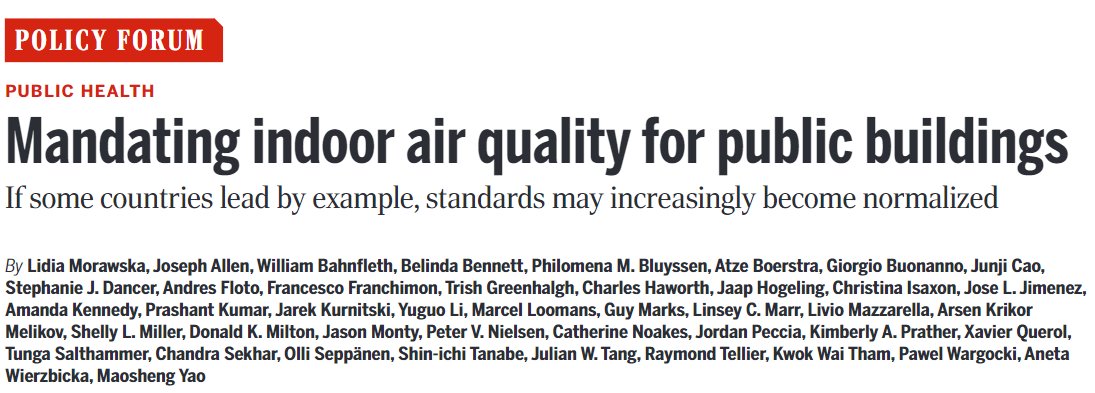1/ CO2 and COVID transmission
Our paper (former preprint) is now published after peer-review in Environ. Sci. Tech. Letters:
pubs.acs.org/doi/10.1021/ac…

Our paper (former preprint) is now published after peer-review in Environ. Sci. Tech. Letters:
pubs.acs.org/doi/10.1021/ac…

2/ Key concept, pioneered by Rudnick & Milton (2003), is that CO2 and airborne pathogens are exhaled at the same time by infectious people
Inhaling shared air with high CO2 increases virus inhaled (if infectious person present) & thus chance of infection
onlinelibrary.wiley.com/doi/abs/10.103…
Inhaling shared air with high CO2 increases virus inhaled (if infectious person present) & thus chance of infection
onlinelibrary.wiley.com/doi/abs/10.103…
3/ Two ways to use CO2: RELATIVE to a situation; and ABSOLUTE (between situations)
RELATIVE is easily understood: wherever you are sharing air, the lower CO2, the lower risk of infection
This is key concept why we recommend CO2 meters (section 9 of )tinyurl.com/faqs-aerosol
RELATIVE is easily understood: wherever you are sharing air, the lower CO2, the lower risk of infection
This is key concept why we recommend CO2 meters (section 9 of )tinyurl.com/faqs-aerosol
4/ The paper does the math to show that indeed the RELATIVE risk increases as CO2 increases. #covidCO2
Importantly, the paper explores the ABSOLUTE risk. Which is more complicated. The key equation is below:
Importantly, the paper explores the ABSOLUTE risk. Which is more complicated. The key equation is below:

5/ In plain English, the summary is that:
- CO2 serves as indicator of RELATIVE risk anywhere (e.g. a choir rehearsal with half the CO2 enhancement is twice as safe as original; same for library)
- ABSOLUTE risk at the same CO2 is much higher at choir rehearsal than library
- CO2 serves as indicator of RELATIVE risk anywhere (e.g. a choir rehearsal with half the CO2 enhancement is twice as safe as original; same for library)
- ABSOLUTE risk at the same CO2 is much higher at choir rehearsal than library
6/ Which factors increase risk?
- Strong vocalization (much more virus out)
- Lack of masking (more virus out and breathed in)
- Breathed volume (e.g. exercise, more virus inhaled)
- Event duration (more virus inhaled)
- Infection rate in population (chance of infected present)
- Strong vocalization (much more virus out)
- Lack of masking (more virus out and breathed in)
- Breathed volume (e.g. exercise, more virus inhaled)
- Event duration (more virus inhaled)
- Infection rate in population (chance of infected present)
7/ You can estimate the amount of CO2 present in a given activity with our COVID Aerosol Transmission Estimator:
If you do the measurements for an activity, adjust ventilation rate till you match observed CO2 *average*tinyurl.com/covid-estimator
If you do the measurements for an activity, adjust ventilation rate till you match observed CO2 *average*tinyurl.com/covid-estimator
8/ The paper should be of most interest to scientists. These details are too complex for most people. Key ideas are simpler:
- Always higher RELATIVE risk of infection as CO2 increases
- Some places much riskier than others: loud vocalization, long time, exercise, unmasked...
- Always higher RELATIVE risk of infection as CO2 increases
- Some places much riskier than others: loud vocalization, long time, exercise, unmasked...
9/ I do believe that monitoring ventilation using low-cost shared CO2 meters is a key strategy to get out of the pandemic.
I've put my money where my mouth is and donated thousands of $$ worth of CO2 meters:
I've put my money where my mouth is and donated thousands of $$ worth of CO2 meters:
https://twitter.com/jljcolorado/status/1377710498855141376
10/ If you can contribute a little to donate more high-quality CO2 meters to places that can't get them, you can do so here. So far we have donated 67 in total:
gofundme.com/f/medidores-co…
gofundme.com/f/medidores-co…
11/ If some of the air is being filtered (e.g. by portable HEPA filters), those remove the virus (as @FloriVilla3 has demonstrated by measuring it in the filters) but not CO2.
Then you can tolerate higher CO2. But high CO2 leads to cognitive decline, so it shouldn't be >> 1000
Then you can tolerate higher CO2. But high CO2 leads to cognitive decline, so it shouldn't be >> 1000
13/ Some explanations of these concepts in @elpaisinenglish which are easier to understand than our paper:
https://twitter.com/jljcolorado/status/1376667218960920578
14/ And more details about CO2 (sorry, only in Spanish for this one, but you can hit translate button):
https://twitter.com/jljcolorado/status/1343196429779673088
15/ And of course CO2 serves to reduce the risk of transmission in shared room air *assuming that physical distance is kept*
In close proximity of someone infected, infection risk is higher (since re-breathed CO2 is also much higher than the room level, which is what we measure)
In close proximity of someone infected, infection risk is higher (since re-breathed CO2 is also much higher than the room level, which is what we measure)
16/ If someone wants the PDF of the paper, just send me an email and I can send it to you.
Unfortunately too expensive to make it open access ($4k)
But thread and other linked documents should be enough for most ppl. Paper most useful for other scientists.
Unfortunately too expensive to make it open access ($4k)
But thread and other linked documents should be enough for most ppl. Paper most useful for other scientists.
17/ Someone seems to have put the article PDF here. I verified that it is the real article, for those interested:
drive.google.com/file/d/14JwYs5…
drive.google.com/file/d/14JwYs5…
18/ Our paper about CO2 as indicator of the risk of infection has been made publicly available in PubMed. It can be read at:
#covidCO2ncbi.nlm.nih.gov/pmc/articles/P…
#covidCO2ncbi.nlm.nih.gov/pmc/articles/P…
• • •
Missing some Tweet in this thread? You can try to
force a refresh











